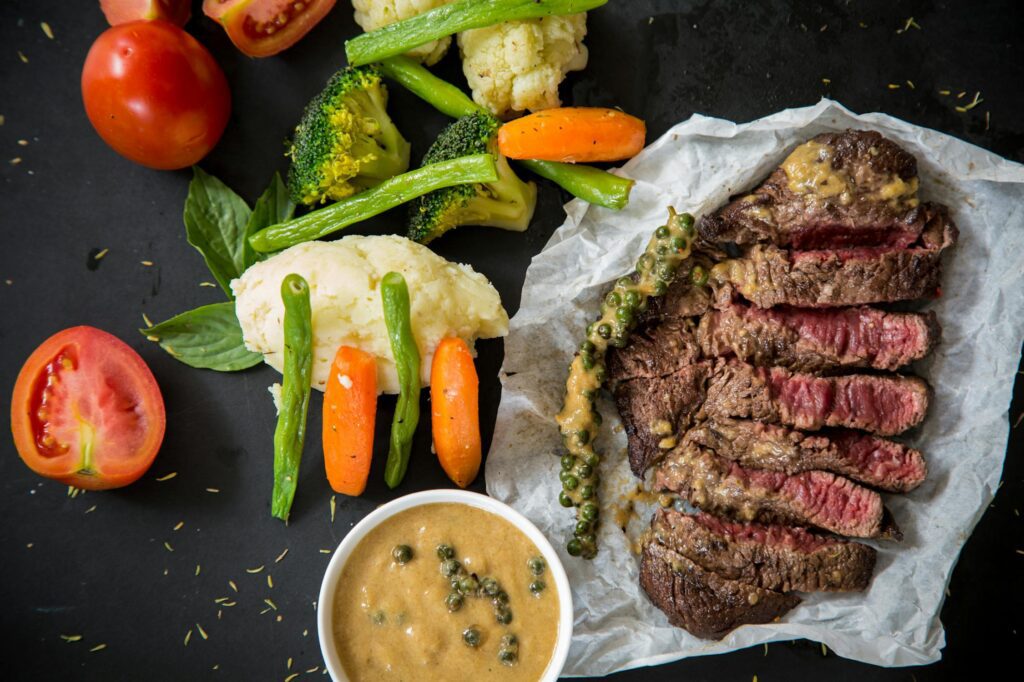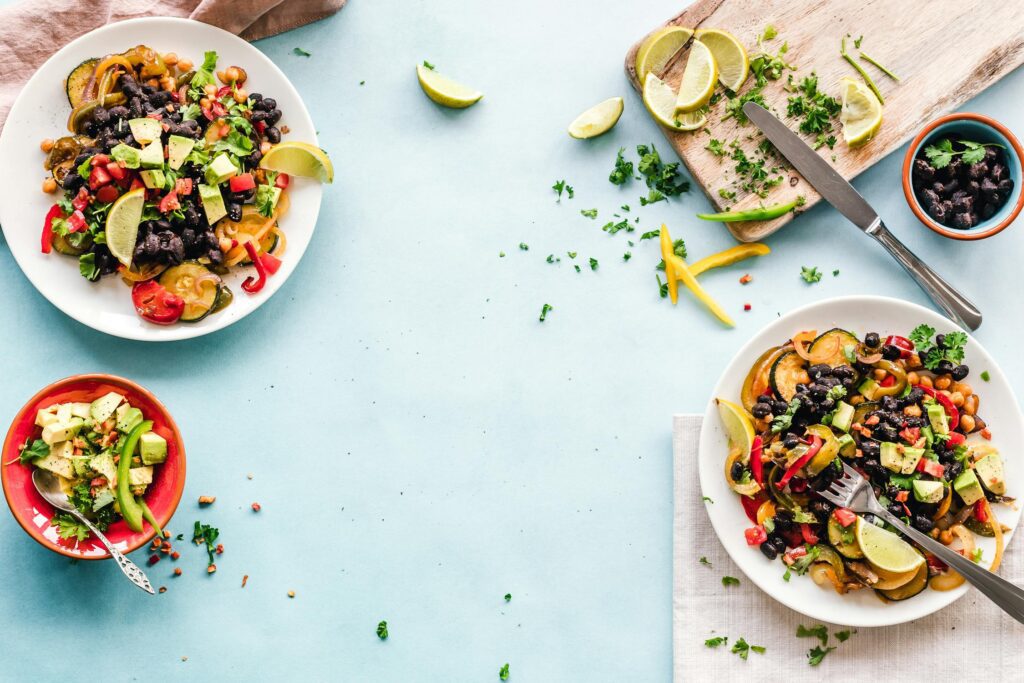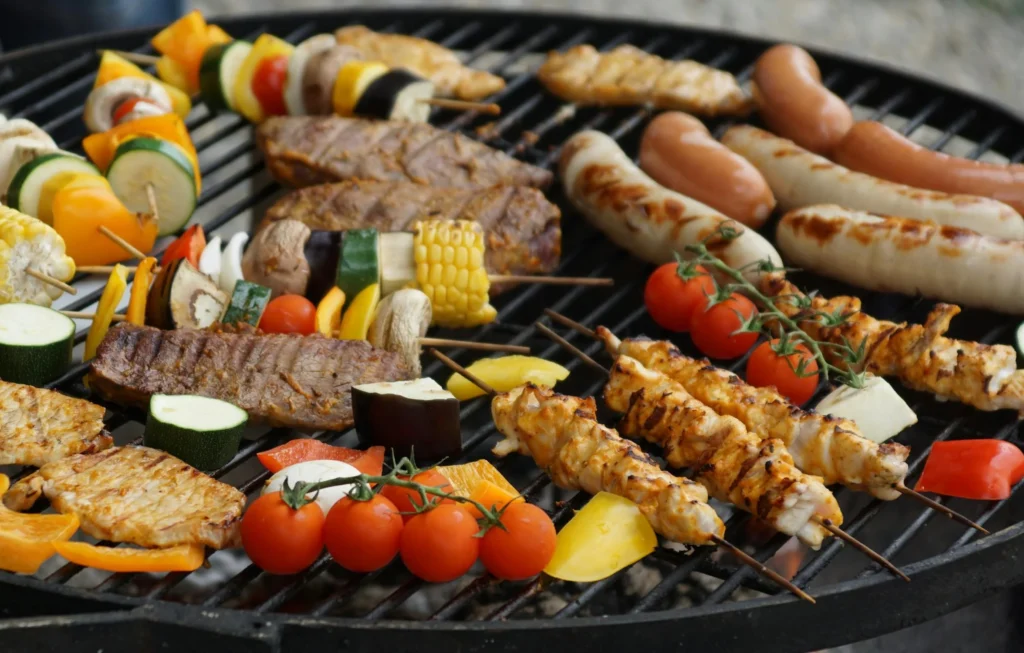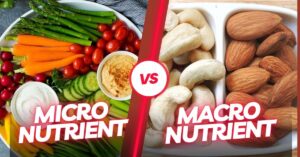Table of Contents
ToggleIntroduction to Macronutrients and Weight Loss:
In this blog post learn about meal prep recipes. While trying to lose weight, the priority is on calories and what has been consumed. Nevertheless, that is not the whole narrative. To lose weight and keep it off, one has to learn about macronutrients and their importance: proteins, carbohydrates, and fats. These three macronutrients are simply the components of a healthy diet, whereby each has a specific function, such as supplying energy, enhancing the development of muscles, and helping the body burn fat.
A macronutrient-oriented technique for reducing weight does not imply that you should stop eating completely certain food groups. In this specific instance, it is finding a way to achieve optimal caloric intake without excess or deprivation of these important nutrients. With this strategy, you not only lose undesirable weight, but you also preserve muscle, remain active, and avoid starving.
The macronutrient components that you need to understand and incorporate, if you have not yet done so, in your regimen will be discussed, as well as weight reduction techniques that require specialized nutrition and a full week of meals appropriate for the goals. Whether tracking or programs are novel for you or you want to improve your knowledge in this area, the guiding principles of this intellect handbook will assist you immensely.
Understanding Macronutrients: Proteins, Carbohydrates and Fats:

Among the essential nutrients, macronutrients are the most responsible for providing energy to our bodies and also defining the ways we lose, gain, or maintain our weight. However, one should first understand the importance of each macronutrient, protein, carbohydrate, and fat before designing a diet that will help lose weight and ensure good health.
Proteins: Constructing Muscle Mass and Enhancing Feelings of Fullness:
When it comes to protein, most people would peg it in the losing weight diet bin. This is so because proteins are vital for muscle growth, maintenance, and repair after exercise. In weight loss requirements, one needs to make sure that they are losing weight in the form of fat and not muscle. Protein serves as the body’s major defender against lean tissue loss instead of fat with regard to weight loss efforts. This is important as muscle burns more calories during rest than fat.
Protein is also satiating, which means it helps one stay feeling full for a longer period after meals. This can help prevent calorie overload, especially snacking or pigging out on food after mealtimes. Some obvious examples of protein sources include lean meats, eggs, dairy products, certain legumes, and some forms of plant protein, such as tofu and tempeh.
Carbohydrates: Your Body’s Primary Energy Source:
Carbohydrates have gained a bad reputation in many popular diets, but they are indeed the best energy source for your body. When you take in carbohydrates, your body converts them into glucose, which serves as the energy for the performance of all physical activities and body functions.
However, not all carbohydrates are created equal. Simple carbohydrates, such as sweet treats and white bread, can lead to quick spikes in blood sugar levels and are frequently treated as a reason for weight gain. However, complex carbohydrates, such as those found in whole grains, vegetables, and legumes, take time to digest and, therefore, help slow the release of energy and avoid hunger.
As far as weight loss is concerned, these complex carbs should be the emphasis and some proteins and healthy fats should be added to the mix to create satisfactory meals and balance blood sugars to prevent a feeding frenzy.
Fats: Essential for Hormonal Balance and Satiety:
Fat is yet another type of macronutrient that people do not fully understand, and it is more often than not blamed for being overweight. Cellular fat plays an important role in energy regulation as well as several other physiological processes, like hormonal regulation and ingredient uptake. In addition to this, fats are also very filling, making it so that after a meal, one does not feel the urge to overeat.
For all these years, humans have only focused on fat as a negative ‘thing’ that makes one gain weight. The greatest approach is to use the right types of fats rather than eliminating all kinds of fats. There are beneficial fats, such as avocados, nuts, seeds, and olive oil, which help reduce weight by improving satiety and reducing the likelihood of consuming unhealthy calories. Conversely, trans fats and unnecessary saturated fats should be restricted as they are linked to heart diseases and accumulating weight and sugars.
Designing Your Macronutrient Meal Plan:
Making a macronutrient that helps lose weight appears to be quite a calculating, tailoring, and organizing process. The important thing is to balance these three nutrients so that accounting for the excess of vegetarian calorie-free fat loss is achieved only by eating the necessary quantity of protein and carbohydrates.
Determining Your Macronutrient Ratios:
The first step in designing your meal plan is to determine the right macronutrient ratio for your body. While the optimal ratio may vary depending on individual factors like age, activity level, and metabolic health, a common starting point for weight loss is:
Protein: 30-35% of total daily calories
Carbohydrates: 35-40% of total daily calories
Fats: 25-30% of total daily calories
These percentages can be adjusted based on how your body responds. For instance, if you find that you’re constantly hungry, you might increase protein or healthy fats. If you’re feeling low on energy, you might need to boost your carbohydrate intake.
Calculating Your Daily Calorie Needs:
To lose weight, you must create a calorie deficit by consuming fewer calories than your body expends. However, it’s important to do this in a sustainable way that doesn’t leave you feeling deprived.
You can estimate your daily calorie needs using this formula:
Calculate your Basal Metabolic Rate (BMR), which represents the number of calories required by your body to maintain basic physiological functions at rest. The Mifflin-St Jeor equation is a popular method:
For women, the BMR can be calculated using the formula: BMR = 10 × weight (kg) + 6.25 × height (cm) – 5 × age (years) – 161.
For men, the BMR formula is: BMR = 10 × weight (kg) + 6.25 × height (cm) – 5 × age (years) + 5
Factor in your activity level: Multiply your BMR by an activity factor to estimate your total daily energy expenditure (TDEE).
Sedentary (little or no exercise): BMR × 1.2
- lightly active (light exercise/sports 1-3 days/week): BMR × 1.375
- Moderately active (moderate exercise/sports 3-5 days/week): BMR × 1.55
- Very active (hard exercise/sports 6-7 days a week): BMR × 1.725
- Super active (very hard exercise, physical job, or training twice a day): BMR × 1.9
Create a calorie deficit: To lose weight, subtract 500-1000 calories from your TDEE. This generally leads to a weight loss of approximately 0.5 to 1 kilogram (1 to 2 pounds) per week.
Planning Your Meals:

Once you’ve determined your daily calorie needs and macronutrient ratios, you can begin planning your meals. Consistency and balance are crucial for success. Aim to include a source of protein, healthy fats, and complex carbohydrates in each meal.
Here’s an example breakdown for a day:
- Breakfast: 30% of daily intake
- Lunch: 30% of daily intake
- Dinner: 30% of daily intake
- Snacks: 10% of daily intake
Using this structure, you can create meals that keep you satisfied throughout the day while ensuring that you’re meeting your macronutrient and calorie goals.
Adjusting Your Plan as You Progress:
Your body’s needs may change as you lose weight or if your activity level fluctuates. It’s important to monitor your progress and adjust your macronutrient ratios or calorie intake as needed. For instance, as you lose weight, your BMR decreases, which means you’ll need to lower your calorie intake slightly to continue losing weight.
Additionally, if you hit a plateau or start to feel overly tired or hungry, it might be a sign that your plan needs tweaking. Don’t be afraid to make small adjustments to keep your progress on track and your body feeling good.
7-Day Macronutrient Meal Plan for Weight Loss:
A well-organized meal plan can significantly influence your success in achieving weight loss. Below is a comprehensive 7-day macronutrient-focused meal plan designed to provide balanced nutrition while helping you stay within your calorie goals.
Each day’s plan includes breakfast, lunch, dinner, and snacks with a macronutrient breakdown to ensure you’re receiving adequate protein, carbohydrates, and fats.
Day 1:
Breakfast:
Scrambled eggs with spinach and mushrooms
Whole-grain toast
1/2 avocado
Macronutrient Breakdown: Protein 20g | Carbs 30g | Fats 25g
Snack:
Greek yogurt with a handful of berries
Macronutrient Breakdown: Protein 15g | Carbs 15g | Fats 5g
Lunch: Grilled chicken salad featuring mixed greens, cherry tomatoes, cucumber, and a drizzle of olive oil dressing.
Quinoa on the side
Macronutrient Breakdown: Protein 30g | Carbs 35g | Fats 20g
Snack:
Apple slices with almond butter
Macronutrient Breakdown: Protein 5g | Carbs 20g | Fats 10g
Dinner:
Baked salmon served with roasted sweet potatoes and steamed broccoli
Macronutrient Breakdown: Protein 35g | Carbs 40g | Fats 25g
Day 2:
Breakfast:
Oatmeal with a scoop of protein powder, topped with banana slices and a sprinkle of cinnamon
Macronutrient Breakdown: Protein 25g | Carbs 45g | Fats 8g
Snack:
Cottage cheese with pineapple chunks
Macronutrient Breakdown: Protein 15g | Carbs 20g | Fats 4g
Lunch:
Turkey and avocado wrapped in a whole-grain tortilla with lettuce and tomato
Side of carrot sticks
Macronutrient Breakdown: Protein 30g | Carbs 40g | Fats 18g
Snack:
Hummus with cucumber slices
Macronutrient Breakdown: Protein 5g | Carbs 15g | Fats 10g
Dinner:
Stir-fry with tofu, mixed vegetables, and brown rice
Macronutrient Breakdown: Protein 25g | Carbs 50g | Fats 15g
Day 3:
Breakfast:
Smoothie with spinach, protein powder, almond milk, and a handful of mixed berries
Macronutrient Breakdown: Protein 25g | Carbs 30g | Fats 10g
Snack:
Hard-boiled eggs with a small handful of mixed nuts
Macronutrient Breakdown: Protein 15g | Carbs 5g | Fats 15g
Lunch:
Grilled shrimp with quinoa, steamed asparagus, and a squeeze of lemon
Macronutrient Breakdown: Protein 30g | Carbs 35g | Fats 12g
Snack:
Sliced bell peppers with guacamole
Macronutrient Breakdown: Protein 4g | Carbs 20g | Fats 15g
Dinner:
Lean beef stir-fry with broccoli, bell peppers, and brown rice
Macronutrient Breakdown: Protein 35g | Carbs 40g | Fats 18g
Day 4:
Breakfast:
Whole-grain toast with peanut butter and sliced banana
Macronutrient Breakdown: Protein 15g | Carbs 40g | Fats 18g
Snack:
Protein bar (choose a low-sugar, high-protein option)
Macronutrient Breakdown: Protein 20g | Carbs 25g | Fats 8g
Lunch:
Grilled chicken breast with sweet potato and a side of salad with vinaigrette
Macronutrient Breakdown: Protein 35g | Carbs 45g | Fats 12g
Snack:
Celery sticks with almond butter
Macronutrient Breakdown: Protein 5g | Carbs 10g | Fats 12g
Dinner:
Baked cod with roasted vegetables and a quinoa pilaf
Macronutrient Breakdown: Protein 30g | Carbs 35g | Fats 10g
Day 5:
Breakfast:
Omelet with bell peppers, onions, and a sprinkle of cheese
Side of whole-grain toast
Macronutrient Breakdown: Protein 20g | Carbs 30g | Fats 20g
Snack:
Apple slices with low-fat cheese
Macronutrient Breakdown: Protein 8g | Carbs 20g | Fats 7g
Lunch:
Tuna salad served with mixed greens, cherry tomatoes, and a drizzle of olive oil dressing
Side of whole-grain crackers
Macronutrient Breakdown: Protein 25g | Carbs 35g | Fats 15g
Snack:
Smoothie with protein powder, spinach, and a small handful of berries
Macronutrient Breakdown: Protein 20g | Carbs 15g | Fats 5g
Dinner:
Grilled chicken with roasted Brussels sprouts and wild rice
Macronutrient Breakdown: Protein 30g | Carbs 40g | Fats 15g
Day 6:
Breakfast:
Greek yogurt topped with granola and a drizzle of honey
Macronutrient Breakdown: Protein 15g | Carbs 40g | Fats 10g
Snack:
Carrot sticks with hummus
Macronutrient Breakdown: Protein 5g | Carbs 15g | Fats 8g
Lunch:
A turkey burger served on a whole-grain bun with lettuce, tomato, and avocado Macronutrient Breakdown: Protein 30g | Carbs 40g | Fats 18g
Snack:
Cottage cheese with sliced peaches
Macronutrient Breakdown: Protein 15g | Carbs 20g | Fats 4g
Dinner:
Grilled salmon with quinoa and roasted green beans
Macronutrient Breakdown: Protein 35g | Carbs 40g | Fats 20g
Day 7:
Breakfast:
Smoothie bowl with mixed berries, a scoop of protein powder, chia seeds, and almond milk
Macronutrient Breakdown: Protein 20g | Carbs 35g | Fats 12g
Snack:
Handful of mixed nuts and an orange
Macronutrient Breakdown: Protein 5g | Carbs 20g | Fats 15g
Lunch:
Grilled chicken Caesar salad with light dressing and a sprinkle of Parmesan
Macronutrient Breakdown: Protein 30g | Carbs 20g | Fats 20g
Snack:
Greek yogurt with a handful of berries
Macronutrient Breakdown: Protein 15g | Carbs 15g | Fats 5g
Dinner:
Baked chicken breast accompanied by steamed broccoli and a serving of wild rice.
Macronutrient Breakdown: Protein 35g | Carbs 40g | Fats 10g
Tips for Success and Common Mistakes to Avoid:
Beginning a diet focused on a macronutrient approach to weight loss is a tactical approach to realizing your objectives. Just like other dietary systems, such a regime needs a settled level of discipline and precision. These tips will assist you in doing so, but you should also be warned against some common mistakes.
Success Strategies:
Meal Prep and Planning: One of the most effective methods for staying on track with your macronutrient goals is to plan and prepare your meals in advance. Designate a specific day every week when you will plan the meals, shop for the groceries, and prep the ingredients. This will free up your time during the week and limit your chances of resorting to unhealthy fast meals.
Monitor Your Macronutrient Intake: Assess your intake of macronutrients with the help of a food journal or a nutrition app that has this extension. This will help you track whether you are meeting the required goals for protein, carbohydrates, and fats on a daily basis. Eventually, you will get accustomed to where the macronutrient content of these foods lies, and thus, you will not need to plan for it fastidiously every time.
Maintain Appropriate Water Intake: Those who want to lose weight and those who are healthy need to drink enough water each day. Water is quite effective in making one feel satiated, facilitating the absorption of nutrients, and burning fat. Most people should strive to drink no less than 8 cups (64 ounces) of water each day, more if they are engaged in physical activities.
Add More of the Northern Comfort Meats:

Consuming a wide variety of different foods, along with all the vital vitamins and minerals, will also prevent you from being bored all the time. Find new and exciting protein, grains, vegetables, and healthy fats to avoid dull meals.
Be in Touch with Yourself:
Sticking to a meal plan is important, but it is also necessary to understand one’s body. If you are especially hungry and have low energy, these may suggest that you need to change your macros or even calorie intake in general. Weight loss takes time, and changes must be made in a manner that does not compromise one’s health.
Be Patient: The most essential trait for achieving results is consistency. Try to follow the macronutrient meal plan as best as you can. However, do not put yourself under unnecessary pressure if you make a mistake. An occasional dessert or skipped exercise regime will not ruin your progress, provided you follow up promptly.
Common Mistakes to Avoid:
Ignoring Portion Sizes: Good food choices promote health or weight control, but eating excessive amounts of healthy foods can have the opposite effect. Controlling portion sizes is important, especially for high-calorie foods such as nuts, oils, avocados, etc.
Over-Restricting Calories: Defining energy intake below energy expenditure is one process essential for reducing fat tissue. Weight loss often requires creating a deficit of calories, but that deficit should be responsibly calculated. Too much caloric deficit defeats its purpose. A cut in caloric intake that is too extreme will cause issues in that one may stagnate or, worse, regain any lost weight.
Neglecting Fats: Some or even most people have been on fat-reduction diets for a long time to reduce the amount of calories consumed. This is appropriate as fats help in the development of hormones, aid brain functioning, and promote satiety. Complete removal of fats from the diet will lead to malnourishment and an outrageous desire for food. Instead, strive to consume only appropriate fats, and in most cases, lightly.
Completing Meals: Skipping meals may sound very innovative and seemingly effective. Often, however, the problem manifests as excess eating later in the day. Alternatively, concentrate on ensuring all meals and snacks are properly balanced with nutrients so that energy levels do not fluctuate excessively and hunger does not build up in an unsettling manner.
Failure to Repurpose the Plan: As you lose weight, your macronutrient requirements may change over time, especially if you change your level of activity or experience a plateau. Constantly track your progress and be ready to adjust your plan if you do not want this situation to happen again.
Not Engaging In Exercise: Diet and exercise are very important for losing weight. Regular exercise can boost your metabolism, increase muscle mass, and enhance overall health. To improve the weight loss process, perform a combination of cardiovascular and weight training.
Conclusion:
Adopting a macronutrient meal plan is a very tactical approach to weight loss that is likely to give lasting results. Understanding the function of the different macronutrients can help one structure their meals in a way that promotes their objectives while still leaving them feeling full and energetic. The 7-day meal plan provided forms the basis of instruction, but the most important target is consistency in planning and attention to the body.
All weight loss plans contain a caloric component that causes the body to lose fat over an extended period. However, the desired weight loss is only attained and sustained by sidestepping identified threats and incorporating incremental step changes. As you do this, be devoted to your plan, adaptable, and, most of all, love being on the journey of becoming a better version of yourself.
Faqs:
What macronutrients are in the world, and which play a major role in weight loss?
When used in this sense, macronutrients include proteins, carbohydrates, and fats and are vital nutritional components that supply energy to living creatures. They help aid fat loss, muscle retention, energy, and appetite control during a caloric deficit.
What is the macronutrient ratio to aid in weight loss? How do I find it?
Start with protein, around 30 to 35% of the daily calorie intake; carbohydrates, within 35 to 40%; and food fats, around 25 to 30%. Revise these as you progress and as your body’s reactions dictate.
What about carbohydrates? Can I eat those and still lose weight?
Yes, I recommend you pay attention to more complex carbohydrates, such as whole grains and vegetables, which supply energy and, at the same time, satisfy you. Gary, simple carbohydrates, such as sugary snacks, should not be taken.
What to do when weight loss stagnates, and there are no more changes?
Consider altering your ratios of macronutrients or calorie limits and trying something different with your workouts. Sometimes, minor changes are adequate to move through plateaus.
Do I have to keep a record of my macronutrients on a daily basis?
That is useful in the beginning phase, but if you already know what you need, you can remain within the limits without day-to-day record keeping. You can then return to monitoring progress if necessary.
What are some of the mistakes you should not make while on a macronutrient meal plan?
The biggest pitfalls include undereating, meal skipping, and neglecting portion control. Remember to include all the macros in your meals—fats, proteins, and carbs.











